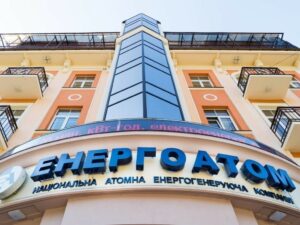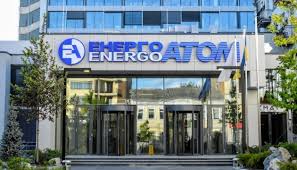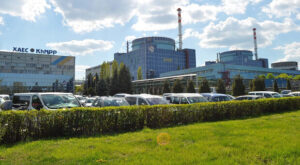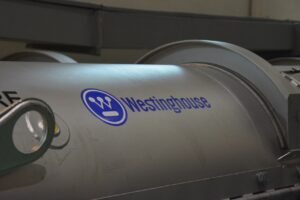
NNEGC Energoatom has received a license from Westinghouse to manufacture fuel rod shanks for nuclear fuel assemblies in Ukraine, the company said on Thursday.
Earlier, NNEGC completed the licensing of the production of heads for fuel cassettes.
“In 2025, we will start supplying both heads and shanks produced at the facilities of Energoatom, a Westinghouse company. That is, some of the elements required for the manufacture of fuel cassettes will be of Ukrainian production,” said NNEGC CEO Petro Kotin in the Energo Live program on the We-Ukraine TV channel.
As reported, cooperation between Energoatom and Westinghouse on the production of nuclear fuel began in the summer of 2018 when the American partner began qualifying one of NNEGC’s separate divisions as a supplier of fuel assemblies for the TVS-WR. In 2019-2020, work was organized to produce them for fuel assemblies of Westinghouse Electric Sweden.
In April 2022, the first batch of head components was manufactured and sent to Westinghouse for qualification.
In the summer of 2023, the Swedish regulator SSM granted an export license as part of the project to qualify NNEGC Energoatom as a supplier of nuclear fuel components manufactured in Ukraine using modern Western technologies.

NNEGC Energoatom and the American company Westinghouse have launched a project to build KhNPP-5 and KhNPP-6 using AR1000 technology.
The project launch ceremony took place on April 11 at the Khmelnytsky NPP site with the participation of US Ambassador to Ukraine Bridget Brink and Minister of Energy of Ukraine Herman Halushchenko (information is being delayed for security reasons).
According to Energoatom’s acting Chairman of the Board Petro Kotin, the AR1000 is a proven III+ reactor with unique fully passive safety systems, modular standard design, industry-leading performance and the ability to operate in maneuvering mode.
“This is a more modern and safer technology than the ones we are currently operating. This is a new step towards more modern, reliable and safe energy. And it is in Ukraine that the first power unit in Europe based on AR1000 technology will be built. This will be KhNPP-5,” said Kotin.
“We are proud to be involved in the history that Ukraine is making in the energy sector. We can already say that our cooperation is the wedding of the year,” said Patrick Fragman, President and CEO of Westinghouse Electric Company.
He emphasized that this is an improved technology with increased efficiency, and the power unit itself is compact and has a lower cost compared to others.
“Here, at the KhNPP site, we note that the heavy equipment, which takes the longest time to produce, is already ready, and this will significantly accelerate the construction time. Thanks to the assistance of the U.S. government and the fact that the main agreements have been signed, it will be even faster,” he emphasized.
Fragman added that the AR1000 reactor is designed to operate for 60 years, but, according to him, it is likely to be longer.
“These units allow for balancing. This is a special feature of the American AR1000 technology. Now Russian aggressors are destroying Ukraine’s balancing capacities, and if we already had such a nuclear power unit, we could maneuver it and, accordingly, perform important functions for the power system,” Galushchenko emphasized.
“This is a project for the next many years. The United States is committed to fruitful cooperation with Ukraine… Together with the U.S. Congress, we are trying to support you not only in the context of armed aggression, but also economically,” Brink emphasized.
Regarding the sources of funding for the project, Kotin said the company could finance it on its own, as it has large profits, but the lion’s share of them goes to cover the electricity tariff for households (PSO).
“Last year, Energoatom spent UAH 128 billion of its net profit on PSO. If the company is exempted from PSO, we will have $3 billion of profit for which we can build a unit. If not, we will need to take out loans,” Kotin told reporters after the ceremony.
He added that the construction period for one unit is approximately 4-5 years, and its cost is about $5 billion.
As reported, on December 17, 2023, in Kyiv, Energoatom CEO Petro Kotin and Westinghouse CEO Patrick Fragman signed a contract for the purchase of a reactor unit for Ukraine’s first nuclear power unit using AP1000 technology.
Prior to this, in July 2022, the companies signed a contract to develop an updated feasibility study for the construction of two AP1000 units at the Khmelnytsky NPP site.
In September 2021, Energoatom and Westinghouse signed a memorandum on the construction of five nuclear power units in Ukraine. In June 2022, the companies signed agreements to increase the number of nuclear power units under construction using AP1000 technology in Ukraine from five to nine units and to establish a Westinghouse engineering and technical center in the country.

NAEK Energoatom and the American company Westinghouse started the project of KNPP-5 and KNPP-6 construction using AR1000 technology.
The project launch ceremony was held on April 11 at the Khmelnytsky nuclear plant site with the participation of U.S. Ambassador to Ukraine Bridget Brink and Ukrainian Energy Minister German Galushchenko (information is delayed for security reasons).
As Energoatom Acting Chairman Petro Kotin noted at the ceremony, the AR1000 is a proven Reactor III with unique fully passive safety systems, modular standard design, industry-leading performance and maneuverability.
“It is a more advanced and safer technology than the ones we currently operate. It is a new step towards a more modern, reliable and safe energy industry. And it is in Ukraine that Europe’s first power unit based on AR1000 technology will be built. It will be KNPP-5,” Kotin said.
“We are proud that we will join the history that Ukraine is making in the energy sector. We can already say that our cooperation is the wedding of the year,” Patrick Fragman, President and CEO of Westinghouse Electric Company, pointed out.
He emphasized that it is an improved technology with increased efficiency, and the unit itself is compact and lower cost compared to others.
“Here at the KNPP site, we note that the heavy equipment, which takes the longest to manufacture, is now ready, and this will significantly accelerate the construction schedule. Thanks to the assistance of the US government and the fact that the main agreements have been signed, it will be even faster,” he emphasized.
Fragman added that the AR1000 reactor is designed to operate for 60 years, but he said it is likely to be longer.
“These units provide a balancing act. This is a special feature of the American AR1000 technology. Now Russian aggressors are destroying Ukraine’s balancing capacity, and if we already had such a nuclear power unit, we could maneuver it and accordingly perform important functions for the energy system,” Galushchenko stressed.
“This is a project for the next long years. The US is set for fruitful cooperation with Ukraine… We are trying together with the US Congress to support you not only within the framework of armed aggression, but also economically,” Brink emphasized.
As for the sources of financing the project, according to Kotin, the company could provide it on its own, as it has large profits, but the lion’s share of them goes to cover the tariff for electricity for the population (PEP).
“Energoatom spent 128 billion UAH of net profit on the PCO in the previous year. If the company is exempted from the PCO, we will have $3 bln of profit for which we can build the unit. If not, we are talking about loans,” Kotin told reporters after the ceremony.
He added that the construction period of one block is tentatively 4-5 years, and its cost is about $5 billion.
As reported, on December 17, 2023 in Kiev, the head of Energoatom Petro Kotin and Westinghouse CEO Patrick Fragman signed a contract for the purchase of a reactor unit for Ukraine’s first nuclear power unit based on AP1000 technology.

Fresh nuclear fuel from Westinghouse (USA) for two power units of Khmelnytsky NPP with VVER-1000 reactors has been delivered to the plant site, the press service of NNEGC Energoatom reported on Friday.
According to the press service, fuel will be loaded into KhNPP reactors this year during scheduled preventive maintenance.
“Before that, two KhNPP units were operating on Russian fuel purchased before the full-scale invasion. After February 24, 2022, Energoatom completely ceased cooperation with the aggressor country. From now on, all domestic nuclear power plants will use American fuel assemblies,” the statement said.
The press service noted that the company has carried out a number of technical works and purchased the necessary equipment to ensure that all Ukrainian NPP units with VVER-1000 and VVER-440 reactors operate on Westinghouse fuel.
As reported, in 2000, in order to diversify the sources of nuclear fuel supply for Ukrainian NPPs, Energoatom and Westinghouse launched a project to qualify Westinghouse’s nuclear fuel. The first nuclear fuel supply contract between the parties was signed in 2008.
In June 2022, Energoatom and Westinghouse signed an agreement on the supply of nuclear fuel for all Ukrainian NPPs.
In September 2023, Energoatom became the world’s first power generating company to operate Soviet-designed reactors, but implemented a project to diversify nuclear fuel for VVER-1000 and VVER-440 reactors.

Ukrainian nuclear power plants will be able to fully switch to fuel from the American company Westinghouse by the end of 2023, Ukrainian Energy Minister Herman Galushchenko said.
“We have quite optimistic forecasts and confirmation that our cooperation with Westinghouse will enable us to implement this process (provision of American fuel – ER) already by the end of this year,” the minister said on the air of national TV marathon “United News” on Thursday, referring to his visit to the American partners’ fuel fabrication plant.
At that he noted that Ukrainian specialists present at the plant “are doing a lot to produce the corresponding fuel as soon as possible in order to replace the Russian fuel.
Answering the presenter’s question about the prospects of nuclear fuel production in Ukraine, the head of the Ministry of Energy said: “We also have relevant agreements with Westinghouse to build a nuclear fuel production plant in Ukraine. There is no doubt that this will be done.
Along with this Galushchenko paid attention to the fact that the whole Europe is now very urgent to stop using Russian nuclear fuel.
“During our meetings with ministers of power of EU and USA we discussed in details that it is important to ensure fuel production in necessary amount as soon as possible in order to replace Russian fuel in European market”, – he explained, adding that it is impossible to quickly find nuclear fuel substitute, unlike, for example, for gas, because it is produced in certain amount, and increase of amount requires time.
At the same time the minister emphasized that the Russians have almost a monopoly position on the market of fuel for VVER-440 units.
“The Minister stressed that the Russian Federation is nearly a monopolist on the market of VVER-440 power units, therefore we are working to ensure that Westinghouse starts producing assemblies for these units this year which will help to get rid of strong dependence on Rosatom in this area.
As reported, in early March 2022, after a full-scale invasion of Ukraine by Russia, Energoatom completely abandoned the purchase of Russian nuclear fuel.
On June 2, at the Khmelnitsky nuclear power plant, Energoatom and the US Westinghouse signed an agreement to supply nuclear fuel to all Ukrainian nuclear power plants with 15 power units (currently 7 power units are loaded with this fuel – ER).
Before this in the very beginning of 2022 Peter Kotin, President of Energoatom, in his comments to Interfax-Ukraine noted that it would take Westinghouse about two years to be ready to cover the fuel demand of the NAEK for 13 existing VVER-1000 units, for which time the nuclear power plants have enough fuel.
Asked about the timing of Westinghouse fuel deliveries for the two VVER-440s at the Rivne NPP, Kotin indicated that the first batch of American fuel for VVER-440s will be delivered in 2025.
Then in a March 2022 interview with Interfax-Ukraine, Kotin explained that there were no questions about fuel for VVER-1000, while more effort was needed for fuel for VVER-440 so that Westinghouse would have time to provide supplies next year, which is 2023.
At the same time, Kotin noted that Energoatom is also optimizing fuel delivery schedules so that the U.S. partners can meet the fuel demand. According to him, due to the reduced consumption of electricity during the war, which resulted in reduced production, the units will be able to work longer on the fuel already brought in.
As part of the cooperation, Energoatom and Westinghouse launched a training program for Ukrainian nuclear specialists in the United States, under which more than 60 specialists and nuclear graduates will study the AP1000® technology.

Energoatom and American Westinghouse are launching an internship program for Ukrainian nuclear scientists in the United States, within which more than 60 specialists and graduates of nuclear specialties will study AP1000® technology.
“Westinghouse Electric and Energoatom announced today a partnership, thanks to which more than 60 Ukrainian nuclear scientists and senior students will be able to take internships and get opportunities for development,” the company said on the Telegram channel on Wednesday.
The multi-year hands-on AP1000® technology training program will begin in the fall of 2022 at Westinghouse’s US headquarters. Upon completion of the training course, newly minted AP1000® technology technicians will have numerous opportunities to apply their engineering, technical and process support skills to new unit construction projects using this technology in Ukraine, in particular at the newly established Westinghouse Engineering and Technology Center in Kyiv, Energoatom said.
Specialists will also be trained to provide critical support for future decommissioning programs at Ukrainian nuclear power plants, the company added.
According to Oleh Boyaryntsev, Executive Director for Human Resources at Energoatom, the most talented and promising young professionals and graduates of leading Ukrainian universities will be selected for the internship.
“Thanks to the Westinghouse training program, Ukrainian specialists and students will receive a unique experience for development in the nuclear industry as we begin to implement AP1000® projects throughout Ukraine,” David Durham, president of Westinghouse Energy Systems, is quoted in the message.
He stressed that the opening of Westinghouse facilities for current and future Ukrainian nuclear scientists strengthens the company’s close partnership with Energoatom and Ukraine.
As reported, in June 2022, Westinghouse and Energoatom expanded agreements for the supply of nuclear fuel for all operating Ukrainian nuclear power plants and construction of nine AP1000® power units.